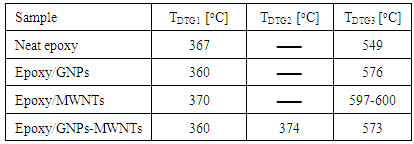-
Paper Information
- Next Paper
- Paper Submission
-
Journal Information
- About This Journal
- Editorial Board
- Current Issue
- Archive
- Author Guidelines
- Contact Us
American Journal of Materials Science
p-ISSN: 2162-9382 e-ISSN: 2162-8424
2017; 7(1): 1-11
doi:10.5923/j.materials.20170701.01

Synergetic Effects of Graphene and Nonfunctionalized Carbon Nanotubes Hybrid Reinforced Epoxy Matrix on Mechanical, Thermal and Wettability Properties of Nanocomposites
Ahmed A. Moosa1, Ahmad Ramazani S. A.2, Faris Abdul Karim Kubba3, Maysam Raad1
1Department of Materials Engineering Technology, Engineering Technical College, Middle Technical University Baghdad, Iraq
2Department of Chemical and Petroleum Engineering, Sharif University of Technology, Tehran, Iran
3Engineering Technical College, Middle Technical University Baghdad, Iraq
Correspondence to: Ahmed A. Moosa, Department of Materials Engineering Technology, Engineering Technical College, Middle Technical University Baghdad, Iraq.
| Email: |  |
Copyright © 2017 Scientific & Academic Publishing. All Rights Reserved.
This work is licensed under the Creative Commons Attribution International License (CC BY).
http://creativecommons.org/licenses/by/4.0/

In this study we focused on the effect of Graphene Nanoplates (GNPs) and Nonfunctionalized Multi Wall Carbon Nanotubes (MWCNTs) hybrid nanofiller and its dispersion on mechanical, wettability, and thermal stability properties of epoxy nanocomposites. The epoxy resin was mixed with 0.5wt. % (GNPs-MWNTs) by direct mixing method using different (GNPs:MWNTs) ratio as (0:10, 1:9, 2.5:7.5, 5:5, 7.5:2.5, 9:1 and 10:0). The dispersionability of carbon nanofiller in epoxy nanocomposite samples was examined by FESEM. The results indicate that epoxy /GNPs significantly out-perform MWNTs additives. The superiority of GNPs in terms of mechanical properties improvement over MWNTs may be due to their high aspect ratio, improved nanofiller matrix adhesion/interlocking arising from their wrinkled surface, and their geometry (2D structure). The best improvements in mechanical properties was found at two mixing ratios of GNPs: MWNTs (5:5) and (9:1). The improved mechanical properties of epoxy/GNPs- MWNTs hybrid nanocomposite is related to the formation of 3-D hybrid architectures structure in epoxy matrix as confirmed by FESEM observations. The hydrophobicity of Epoxy/0.5 wt. % MWNTs is higher than that of epoxy/0.5wt.% GNPs, where contact angle of Epoxy/MWNTs is larger than that of epoxy/ 0.5wt. % GNPs and water absorption of Epoxy/ 0.5wt. % MWNTs is less than that for epoxy/ 0.5wt. % GNPs. Hydrophilicity of neat epoxy decreases by adding 0.5 wt.% GNPs-MWNTs with mixing ratio 2.5:7.5 where contact angles are changed from 43.5° to 79.5°. Thermogravimetric analysis results for neat epoxy, Epoxy/MWNTs, Epoxy/GNPs, and Epoxy/GNPs-MWNTs do not show any major influence on thermal stability of epoxy.
Keywords: Hybrid nanocomposites, Multi-walled carbon nanotubes, Graphene, Epoxy, Tensile Strength
Cite this paper: Ahmed A. Moosa, Ahmad Ramazani S. A., Faris Abdul Karim Kubba, Maysam Raad, Synergetic Effects of Graphene and Nonfunctionalized Carbon Nanotubes Hybrid Reinforced Epoxy Matrix on Mechanical, Thermal and Wettability Properties of Nanocomposites, American Journal of Materials Science, Vol. 7 No. 1, 2017, pp. 1-11. doi: 10.5923/j.materials.20170701.01.
Article Outline
1. Introduction
- The significant improvement of the properties of polymeric materials can be achieved by adding nanofillers. The properties of Polymer nanocomposites are significantly higher than properties of conventional composites. Where it has unique combination of electrical, mechanical and thermal properties [1]. These properties depending on the type and loading amounts of the fillers, matrix, the nanofiller dispersion and the type of bonding at matrix/nanofiller interface [2, 3]. Polymer nanocomposites have been used in various fields of engineering and science such as electronics, sensors, photovoltaic cell, coating and mechanical structures for a lot various applications such as automotive industries, aerospace industries, medical equipment, defense systems.Carbon nanotubs (CNTs) have been used as a prominent nanofiller material since their discovery in 1991 by Iijima [4]. Graphene nanoplates (GNPs) have attached the attention of many researchers since their discovery in 2004 by Navoselov [5] because of its unique properties.GNP is a honeycomb lattice structure of sp2 hybridized carbon atoms arranged into a two-dimensional (2D) planar monolayer with a carbon–carbon bond length of 0.142 nm [1, 5]. CNTs are long-hollow cylinder structures formed by rolling single layer or multilayer's of graphene into one-dimensional (1D), which are honeycomb hexagonal lattice of the carbon’s atoms have sp2 hybridization and capped by half – fullerenes [6, 7].Carbon nanotubes (CNTs) and graphene nanoplates (GNPs) share many similar properties, but on the other hand differ in other aspects because of the structural differences. Attempts have recently been made to integrate these two carbon-based materials in order to utilize the merits of both [8]. Carbon nanotubes possess excellent electrical conductivity and they can be added to a poor electroconductive polymer and enhances its electrical properties [9]. Similarly, graphite nanoplatelets (GNPs) possess excellent thermal conductivity of 3000 Wm−1K−1 and they can successfully improve the thermal conductivity of polymer [10].Graphene exhibits extraordinary properties. These properties emerge only in the 2D planar direction of the graphene structure, limiting its scope and applications. This weakness was overcome by adding (1-D) MWCNTs to (2-D) GNPs to form 3D structures. In these (3-D) hybrid architectures, these arms entangle with polymer chain to provide stronger interaction between MWCNTs/ GNPs and the epoxy matrix which Minimizing the aggregation of GNPs [11]. Thus, the combining (1-D) MWCNTs and (2-D) GNPs will become very important concepts for improving the performance of graphene-based polymer nanocomposites and may be a solution to an ever increasing market demand for polymer nanocomposites with balanced mechanical properties. The advantage of polymer nanocomposite is to provide newly added good properties to the neat polymer without sacrificing its processability, light weight and inherent mechanical properties [12]. Several challenges need to be resolved in order to utilize the enhanced mechanical, electrical, thermal, optical, and chemical properties of nanocomposites. These challenges include: the development of better dispersion methods of nanofillers in polymeric matrices; to develop a proper techniques to control the interface and to reduce the cost [11]. The aim of this work is to study the effect of dispersion of GNPs with nonfunctionalize MultiWalls Carbon Nanotubes (MWNTs) as hybrid nanofillers on mechanical, wettability and thermal stability properties of polymer nanocomposite. The Epoxy/GNPs-MWNTs nanocomposites have fixed weight fraction of nanofillers and prepared under the same process conditions and parameters.
2. Experimental Work
2.1. Materials
- Epoxy resin (Epikote 828) (density = 1.16 g/cm3, viscosity = 110-150 Poise) and aliphatic amines hardener (EPI-CURE curing agent 3234) produced from triethylenetetramine (TETA) were obtained to prepare epoxy nanocomposite samples. Graphene Nanoplates (GNPs), Grade C-750 with 97% purity consist of 4-5 graphene layers with an average diameter of 1 micron and an average thickness of 2 nm was purchased from XG Science Company, Lansing, MI, USA. Nonfunctionalized Multiwalled Carbon Nanotubes (MWCNTs) with 50 𝜇m in length and 8-15 nm in diameter were obtained from Neutrino Nanovation, TECNAN Company, China.
2.2. Preparation of Nanocomposites
- The experimental work was done at (Nano-Technology Center Laboratory/ Institute for Nanotechnology and Nanoscience / Sharif University of Technology/ Tehran/ Iran). The epoxy/GNPs-MWNTs nanocomposites samples were prepared by direct mixing method as reported by Moosa et al., 2016) [13]. The epoxy resin was mixed with 0.5wt.% (GNPs+MWNTs) using different mixing ratio (0:10, 1:9, 2.5:7.5, 5:5, 7.5:2.5, 9:1 and 10:0) of (GNPs:MWNTs).
2.3. Characterization and Instruments
- The tensile properties of epoxy nanocomposite samples were measured using Universal Testing Machine (HIWA 200, model 2125, HIWA Eng. Co., Korea) with loading rate 5 mm/min at room temperature. The fracture surfaces of epoxy/GNPs-MWNTs nanocomposites were examined by Field Emission Scanning Electron Microscope (FESEM) with spatial resolution down to 1.5 nm (Mira 3 Tescan FESEM, Czech).The thermogravimetric (TG) analyzer TGA/DSC 1 (METLER TOLEDO Company, USA) was used under nitrogen gas atmosphere within the temperature range from room temperature to 700°C and heating rate of 10°C/min to evaluate the thermal stability of all the fabricated nanocomposite samples as a function of the temperature.The wettability properties of fabricated nanocomposite samples were characterized by measuring the static contact angles of the liquid drop over the surface of the nanocomposite samples using optical microscope, and the water absorption through the epoxy nanocomposite samples.
3. Results and Discussion
3.1. Tensile Properties of Epoxy/GNPs-MWNTs Nanocomposites
- The tensile strength mechanical properties of Epoxy/GNPs-MWNTs hybrid nanocomposites containing fixed weight fraction of GNPs:MWNTs hybrids (0.5wt%) with different mixing ratio (0:10, 1:9, 2.5:7.5, 5:5, 7.5:2.5, 9:1and 10:0) of GNPs:MWNTs are shown in Figure 1. The tensile strength increments are 27%, 46%, 50%, 53%, 52%, 60% and 59% at GNPs:MWNTs mixing ratios of 0:10, 1:9, 2.5:7.5, 5:5, 7.5:2.5, 9:1and 10:0 respectively.
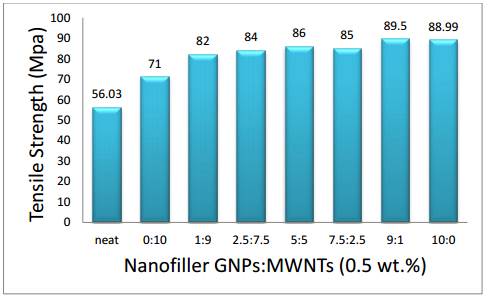 | Figure 1. Tensile strength of Epoxy/GNPs-MWNTs nanocomposites |
 | Figure 2. Young’s modulus of Epoxy/GNPs-MWNTs nanocomposites |
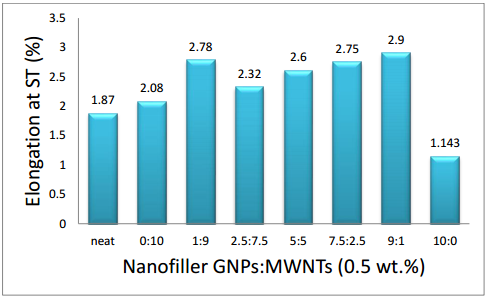 | Figure 3. Elongation at ultimate tensile strength of Epoxy/GNPs-MWNTs nanocomposites |
3.2. FESEM of Fracture Surface of Epoxy/GNPs- MWNTs Hybrid Nanocomposite
- FESEM images of the neat epoxy, Figure 4 (a), shows smooth fracture surface and this means the crack through growth is not obstructed by any obstacles.The FESEM images of Epoxy/GNPs nanocomposite show better dispersion than Epoxy/MWNTs as shown in Figure 4 (b) and Figure 4 (c) respectively. These samples contain fixed weight fraction of nanofillers (0.5 wt. %) and prepared in the same procedure. In the Epoxy/ GNP-MWNTs with mixing ratio 0:10, MWNTs tend to entangle due to Van der Walls attraction forces and π-π interaction between nanotubes. The agglomerates in Epoxy/MWNTs nanocomposite, Figure 4 (c) act as stress concentration sites, which are absence in epoxy/GNPs.In MWNTs reinforced epoxy crack bridging mechanisms play important role in improved fracture toughness of nanocomposite samples. Large energy dissipated within bridging mechanisms due to very small diameter in nanoscale and large length in microscale of nanotubes and crack deviation may take secondary role [15]. When a nanotubes bridge two fracture surfaces, it may either fracture or pulled out from one of the surfaces and appear to lie on the fracture surface depending on the flexibility of the nanotubes, epoxy-nanotubes interfacial strength (interfacial bonding), embedded length and angle to fracture surface of nanocomposite [16].The degree of pulling indicates the weak interfacial bonding between epoxy- nanofiller. No GNPs appeared (no pullout) on fracture surface of Epoxy/ 0.5wt% GNPs and this indicates strong interface interaction, Figure 4(b). In Figure 4 (c), MWNTs appeared (pullout) to lie on the fracture surface and this indicates weak interface interaction between that MWNTs and the epoxy.Figure 4 (d) shows GNPs:MWNTs nanocomposite with mixing ratio 1:9. The MWNTs tend to tangled and twisted with each other and stack on GNPs. Thus, high weight fraction of MWNTs (0.45 wt%) has lower chance to disperse between GNPs. A 3-D hybrid architectures is formed at GNPs:MWNTs mixing ratio of 9:1 , as shown in Figure 4 (e). At low weight fraction of MWNTs (0.05 wt%) there is enough MWNTs to be dispersed between (0.45 wt%) GNPs. For GNPs:MWNTs hybrid nanocomposite with mixing ratio 7.5:2.5, the agglomeration of nanofillers, Figure 4 (f). lower the mechanical properties of the nanocomposites. FESEM image with high magnification for Epoxy/GNPs-MWNTs are shown in Figure 4 (g) and 4(h). Nonfunctionalized MWNTs have better chance to hybrid and bond with GNPs because there are no functional group which impede and reduce the bonding chance as reported by (Moosa et al., 2016) [13].
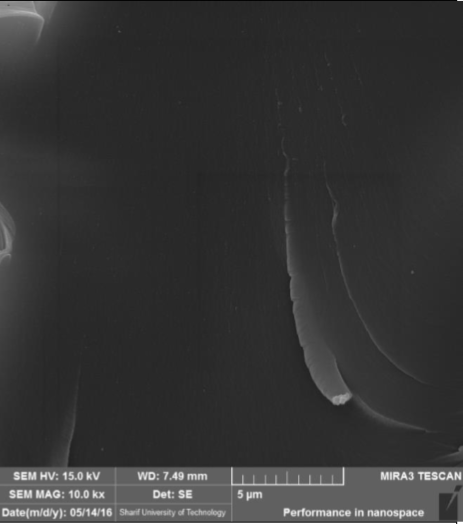 | Figure 4(a). FESEM images of neat epoxy [Mag. 10 kx] |
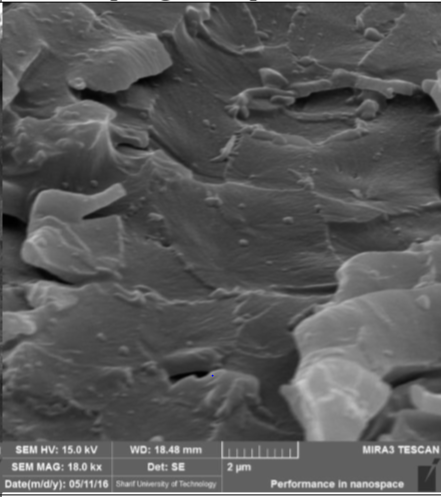 | Figure 4(b). Epoxy/GNPs(0.5wt.%) [Mag. 18.0 kx] |
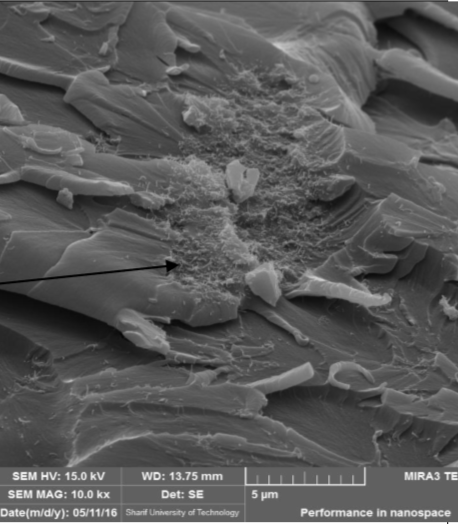 | Figure 4(c). Epoxy/MWNTs (0.5wt.%) [Mag.10.0kx] |
 | Figure 4(d). Epoxy/GNPs-MWNTs [1:9] (0.5 wt.%) [Mag.7.00 kx] |
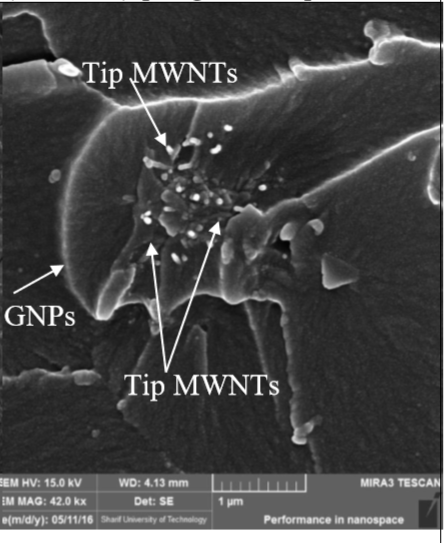 | Figure 4(e). Epoxy/GNPs-MWNTs hybrid [9:1] (0.5 wt.%) [Mag.42.0kx] |
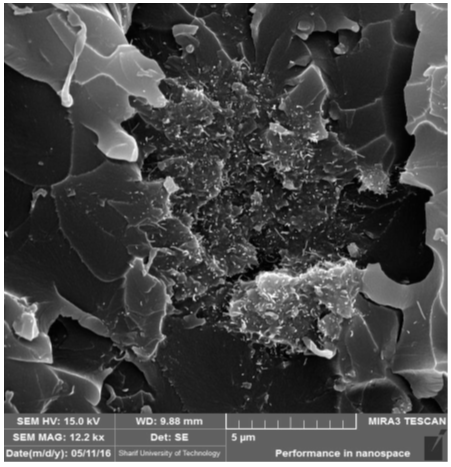 | Figure 4(f). Epoxy/GNPs-MWNTs [7.5:2.5] (0.5 wt.%) [mag.12.2kx] |
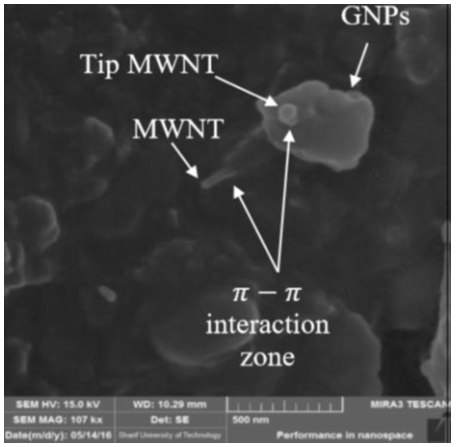 | Figure 4(g). Epoxy/GNPs-MWNTs [5:5] (0.5 wt.%) [mag.107kx] |
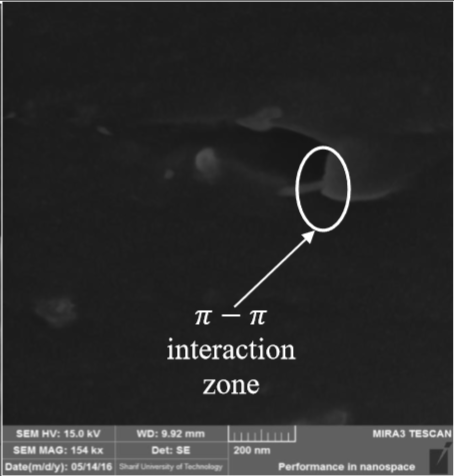 | Figure 4(h). Epoxy/GNPs-MWNTs [1:9] (0.5 wt.%) [mag.154kx] |
3.3. Thermogravimetric Analysis (TGA)
- Residual weight percentage versus temperature curve is shown in Figure 5 where the thermal of the nanocomposite specimens are slightly different. The thermal stability analyses curves, Figure 5, of neat epoxy and its nanocomposite samples can be explain by dividing them into three steps: initial decomposition, Tg curve, and complete decomposition. At the initial very small decomposition appears over all samples, the same may be created by the loss of volatiles. We can evaluate the thermal stability of the neat epoxy and its nanocomposite samples by Td (the temperature at the 5% weight loss identified as the onset temperature of decomposition) and Tmax (the temperature at the 50% weight loss identified as the devastation temperature of composite structure).We can obtain information for the thermal degradation behavior from these details as mention in Table 1. The devastation in composite structure (50% weight loss) occurred when exposed to heat at 396+4°C. Thus, GNPs and MWNTs nanofillers may be affected by the temperature because variation in weight loss at the third stage, where all specimens start variation after temperature 374°C, as shown in Figure 5.
|
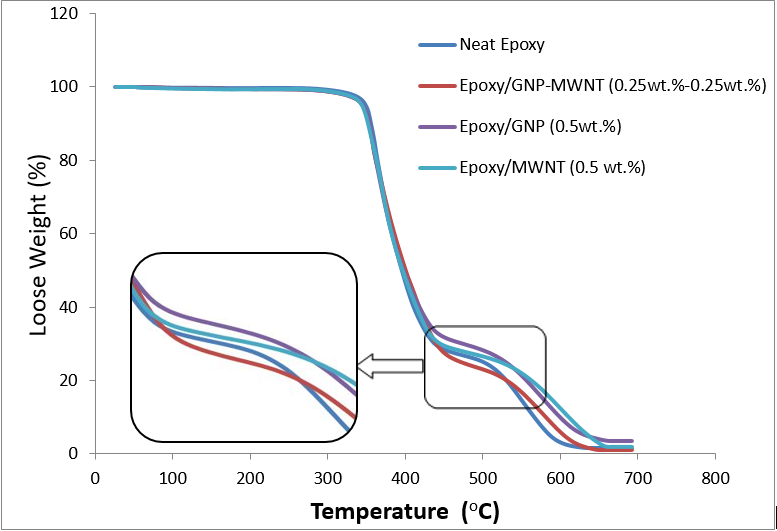 | Figure 5. TGA of neat epoxy and its nanocomposites |
3.4. Differential Thermogravimetry (DTG)
- Differential thermogravimetry (DTG) (first derivative) was used to evaluate the peak degradation temperature of (Neat epoxy, Epoxy/MWNTs, Epoxy/GNPs and Epoxy/GNPs-MWNTs hybrid) with loading amount 0.5 wt.% of nanofillers. Table 2 and Figure 6 show the degradation temperatures (TDTG) of neat epoxy and its nanocomposite samples. The first degradation temperature (TDTG1) for epoxy/GNPs and epoxy/ GNPs-MWNTs hybrid is (360°C) it was 10°C lower than TDTG1 of epoxy/MWNTs and 7°C lower than TDTG1 of neat epoxy. This may be related to good dispersion of GNPs and GNPs-MWNTs hybrid in epoxy. Where GNPs and GNPs-MWNTs hybrid act as barrier hinders the crosslink reaction between epoxy chains, consequently this will reduce the crosslink reaction.
|
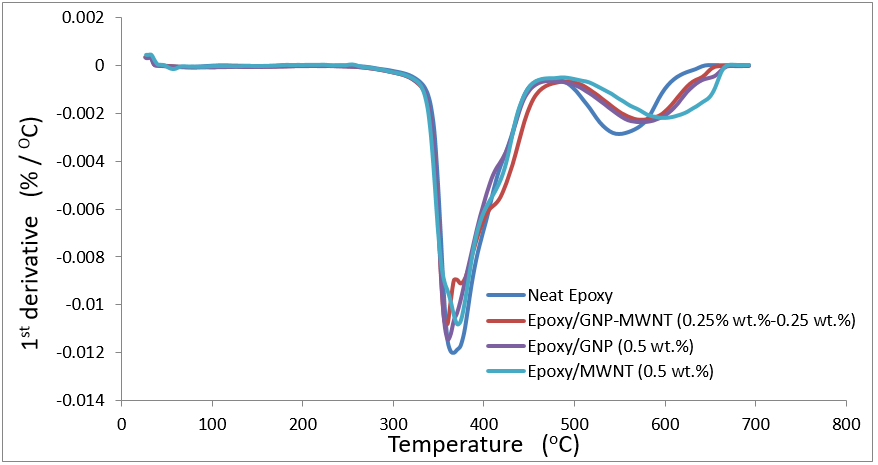 | Figure 6. DTG thermograms for neat epoxy and its nanocomposites |
3.5. Contact Angle of Epoxy/GNPs-MWNTs Nanocomposite
- Figure 7 shows contact angle for Epoxy/GNPs-MWNTs hybrid nanocomposite samples with fixed nanofiller weight fraction (0.5 wt.%) and different mixing ratio (0:10, 1:9, 2.5:7.5, 5:5, 7.5:2.5, 9:1, 10:1). The neat epoxy (hydrophilic) has 43.5° as a contact angle. The contact angles of different ratios of GNPs: MWNTs are higher than that for neat epoxy. The range of contact angle for Epoxy/GNPs-MWNTs composite is between (44.5° - 79.5°) corresponding to GNPs:MWNTs ratio ranges 0:10 – 10:0. The maximum contact angle is 79.5° at GNPs:MWNTs ratio 2.5:7.5 and at this ratio the wettability of Epoxy/GNPs-MWNTs composite decreased. The poor water adhesion is caused by more uniform and compact MWNTs coverage on the graphene nanosheets.Figure 7 indicates that the epoxy / GNPs is more hydrophilic than epoxy / MWNTs with the same weight fraction 0.5% of nanofiller.
 | Figure 7. Contact angle for Epoxy/GNPs-MWNTs Nanocomposites |
3.6. Water Absorption of Epoxy/GNP-MWNT Nanocomposite Samples
- Figure 8 show the water absorption percentage of Epoxy/GNPs-MWNTs hybrid nanocomposite samples with fixed nanofiller weight fraction (0.5 wt. %) and different mixing ratio.
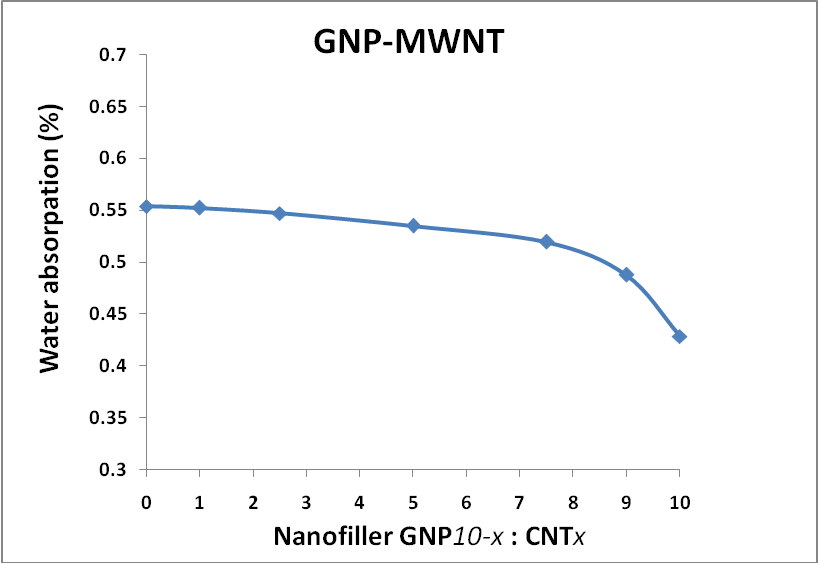 | Figure 8. Water absorption vs.GNPs-MWNTs nano-fillers with fixed weight fraction (0.5 wt. %) at different mixing ratio |
4. Conclusions
- Direct mixing, which include mechanical mixing and high shear mixing followed by sonication, is experimental method used to prepare epoxy/GNPs-MWCNTs hybrid nanocomposites. This method showed Good improvement in stability and dispersion of GNPs-MWCNTs in epoxy with low cost, environmental friendly and fast. The Young’s modulus of the epoxy/GNPs was 62% greater than the neat epoxy as compared to 6% increase for MWNTs. The increase in the ultimate tensile strength is 59% for Epoxy/GNPs, 27% for Epoxy/MWCNTs, as compared with that of the neat epoxy. The best improvements in mechanical properties of was found at two mixing ratios of GNPs: MWNTs (5:5) and (9:1), where ultimate tensile strength of the Epoxy/GNPs-MWNTs with mixing ratio (5:5) and (9:1) was 53% and 60% greater than the neat epoxy respectively. The fracture surface of tensile sample of epoxy/0.5 wt% GNPs nanocomposite indicates that GNPs have uniform good dispersion without agglomeration. For epoxy/GNPs-MWNTs hybrid naocomposites, the fracture surface indicates that the GNPs with MWNTs form 3-D hybrid architectures structure which inhibits face-face aggregation of GNPs. The hydrophobicity of Epoxy/0.5 wt% MWNTs is higher than that for epoxy/0.5 wt% GNPs where contact angles are (60.5° and 44.5°) and water absorption are (0.43% and 0.55%) respectively. Hydrophilicity of neat epoxy decreases by adding 0.5 wt.% GNPs-MWNTs with mixing ratio 2.5:7.5 where contact angles are changed from 43.5° to 79.5°. Thermogravimetric analysis results for neat epoxy, Epoxy/MWNTs, Epoxy/GNPs, and Epoxy/GNPs-MWNTs do not show any major influence on thermal stability of epoxy.
 Abstract
Abstract Reference
Reference Full-Text PDF
Full-Text PDF Full-text HTML
Full-text HTML
